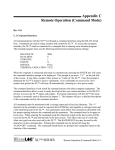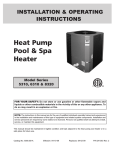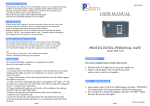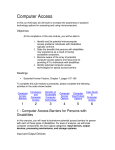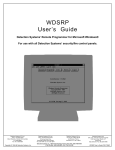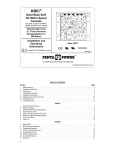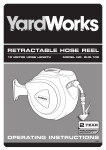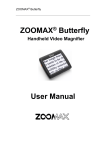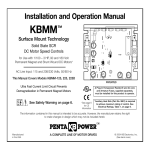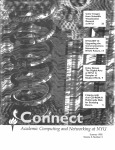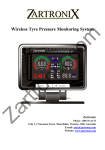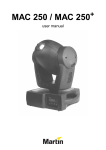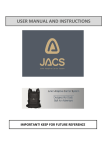Download Report part 2: Lifting & control improvements
Transcript
REHAB Tech- Monash Rehabilitation Technology Research Unit assume no liability for any claim of adverse effects resulting from misapplication of the information presented here in. While every effort is made to ensure the accuracy of the guide no responsibility or liability will be taken for any inaccuracies. REHABTech is finance and supported by In collaboration with © Copyright 1998 All rights reserved. No part of this publication may be reproduced or transmitted in any form or by any means, electronic or mechanical, including photocopy, recording or any information storage and retrieval system, without permission in writing from the publisher. Requests for permission to make copies of any part of the work should be addressed to: REHAB Tech- Monash Rehabilitation Technology Research Unit C/- C.G.M.C. 260 - 294 Kooyong Road CAULFIELD VIC 3162 AUSTRALIA Email [email protected] CHAPTER 1. INTRODUCTION Loosing the ability to walk or to support ones own weight has a strong impact on a persons life and forces a drastic change of lifestyle upon them. A loss of mobility creates numerous problems and usually leaves the effected person less self sufficient and more dependant on others. Therefore gait re-education must be a major part of the rehabilitation process after an injury which results in the loss of walking ability. The three main groups of patients in need of gait re-education are spinal cord injured patients, hemiplegic (stroke) patients and lower limb amputees. Although the causes for these locomotion disabilities differ, some problems are universal, including reduced balance and inability to bear ones full weight. Therefore weight bearing and the support of a patient in an upright position are crucial factors, to allow for rehabilitation to take place. Traditionally, this has been achieved by using parallel bars and assistive devices such as a walking frame. However, there are problems associated with these devices; the amount of weight relief cannot be controlled or monitored, upper body strength and control have to be sufficiently available and a considerable risk of falling is involved. 1 Recently various types of overhead harness support systems have started to come into use with which the problems encountered with traditional assistive devices can more or less be overcome. The patient dons a harness which is attached to a frame that holds them in an upright position. There are several advantages compared to other assistive devices such as parallel bars: • weight relief can be controlled and monitored and slowly decreased as gait re-education progresses • the patient has a more upright and natural stance, depending on what type of harness is used • the upper limbs are not required for support and weight relief • the patient cannot fall and therefore feels less inhibited and more secure These advantages allow the clinician and patient to work more efficiently as they can concentrate on the important factors of gait training such as stepping and balance rather than on other areas such as the risk of falling. The harness systems currently in use can be divided into two main groups: stationary systems which are used in combination with treadmills and mobile systems which allow the patient to move along a walkway. The stationary systems are advantageous for patients with spinal chord injuries as the problem is neurological. The treadmill forces the legs to move at a certain speed producing a continuos gait pattern, thus familiarising and “reprogramming” the brain with the complex actions of walking. On the other hand, an amputee patient would probably benefit more from a mobile system as the problem here is biomechanical. The system is more of a passive system which follows the movement of the patient while they can determine their walking speed. Most experiences made in the area of gait re-education using overhead harness systems seem to indicate that harness systems have positive effects on the rehabilitation process. Patients are more confident, increasing their walking speeds and stride lengths and medical professionals have more precise and focussed methods to work with. It can be assumed that this will result in a shorter rehabilitation time which would be an advantage to both patient and the treating clinic or hospital. CHAPTER 2. DESIGN OF THE ORIGINAL HARNESS SYSTEM BACKGROUND To assist with and study different aspects of gait reeducation of patients with lower limb disabilities (mainly amputee patients) at Monash Rehab Tech, Melbourne, an overhead harness system, now called the Tech Track, was designed. The design incorporated the use of a force plate and a walkway already installed in the Rehab Tech biomechanics Laboratory. To produce a system that would successfully deal with the problems faced by patients and hospital staff during gait reeducation and rehabilitation, three main aspects were considered while designing the Tech Track: 2 • Safety The system needed to guaranty that the patient would not be able to fall, but be kept in an upright position at all times of use. This would allow the patient and the user to concentrate on walking technique rather than being concerned with stability and balance. • Walking assistance The system needed to enable the patient to walk as normally and unrestricted as possible while being given as much support as needed. • Weight bearing The system needed to be able to provide a controllable amount of weight relief to the patient. BASIC DESIGN The design of the original system can be devided into five separate parts: • Track / Carriage • Patient Harness • Weight Relief System • Motorisation • Control System Track / Carriage For the Track a hollow profile tube was chosen (Figure 2.1), which was then bolted to beams in the ceiling of the laboratory. This type of Track is widely used for hoists and conveyors and best suited the purpose at the time. Figure 2.1 Track and Carriage Configuration The Track and carriages chosen have a rating of 650 kg,2 which gives a sufficient safety margin to support a person. Two carriages were used to support the main frame of the harness system, while several others were used to carry power cables and the compressed air hose for the pneumatic weight relief system (Figure 2.1). Patient Harness Three main elements of a patient harness were originally considered to give adequate support and carry the patients weight without undue discomfort and obstruction to gait (Figure 2.2). CROTCH LOOPS SHOULDER LOOPS Figure 2.2: Elements of a Patient Harness for Weight Relief CHEST AND/OR WAIST STRAPS 2 The harness also needed to be detachable from the rest of the system to allow the patient to don and remove the harness while standing or in a wheelchair 2. To allow for this, the harness consists of two parts: the upper part, which is attached to the system via a rope and the jacket, which is worn by the patient. The parts can be easily separated by the two shoulder clips (Figure 2.3 patient harness). Figure 2.3 patient harness After trials revealed that a harness with crotch loops impeded walking considerably, a waistcoat design was chosen for the jacket. With this harness configuration the patient’s weight is carried by padded sections under the arms, several straps across the chest and waist area and a larger strap around the pelvis (Figure 2.3). Weight Relief System A pneumatic system attached to the frame of the main carriage allows for an upward force to be set, which is then kept constant, regardless of the vertical movement of the patient during the gait cycle. This allows for a precise percentage of weight relief to be selected and held at all times. The system functions by supplying constant air pressure to one chamber of a pneumatic actuator and leaving the other open (Figure 2.4 a). This keeps the force constant, regardless of which position the piston is in. The pressure is set by turning the regulator (Figure 2.4 b) which sets the relay regulator to a corresponding pressure of the desired percentage of weight relief. a) PRESSURIZED AIR b) REGULATOR CONSTANT PRESSURE 2 T-JOINT ACTUATOR CONSTANT FORCE RELAY REGULATOR Figure 2.4 Function and set up of the pneumatic system 2 The actuator is located in a horizontal position under the main frame of the carriage. Attached to the piston is a rope, which runs through a pulley and hangs down from the system is attached to the upper section of the patient harness Motorisation The Tech Track is powered by a 0.75 kW permanent magnet motor with a base speed of 1750 rpm and an armature voltage of 180 V DC. The speed of the motor is reduced by a gearbox with a 5:1 ratio. Attached to the motor is a drive wheel, which runs along the outside of the rail (Figure 2.5). The drive wheel has a Diameter of 100mm. This allows for the carriage to travel at a maximum speed of 6.5 km/h which is a sufficient speed for the use of the harness. A wheel on the opposite side of the rail adds stability and can be adjusted to give the driving wheel an adequate amount of Traction. 2 Figure 2.5 Motorisation of the system As can be seen in Figure 2.5 the motor and gearbox have been attached diagonally under the main carriage. This places the centre of gravity of the motor and gearbox directly under the centre of the rail and carriage so as not to over balance the system to either side. Control System The motor speed is controlled by a regenerative-type control, capable of operating a DC motor in a bi-directional, which offers much better controllability than a standard unidirectional speed control.3 The control is situated in a box with a control panel fitted to the wall of the biomechanics laboratory. The control panel consists of the following controls: • Power on/off • Emergency Stop • Motor Start • Motor Stop • Motor Speed Control • Auto/Console (switches the motor speed control between the manual control on the console and the control on the carriage which allows the carriage to follow the patient automatically) The speed control on the carriage is achieved by a potentiometer mounted at the axis of the pulley through which the rope runs. This returns a signal proportional to the angle between the vertical and the rope, determining the position of the patient in regards to the carriage above (Figure 2.6). angle Figure 2.6 Automatic Speed Control 2 The potentiometer sends a velocity request signal directly to the motor controller. The signal from the potentiometer is amplified to allow for the angle of the rope not to become too large before the motor responds. The amount of amplification can be adjusted in the control box so that the speed response of the system can be adjusted to specific needs. Acceleration, deceleration, offset and gain can be adjusted directly on the controller. 2 CHAPTER 3. SUGGESTIONS OF IMPROVEMENT AND FURTHER DEVELOPMENT To evaluate the feasibility of the overhead harness system for gait reeducation a study was conducted in 1996. It involved a number of below knee amputee and able bodied subjects. The subjects walked along the walkway in the Rehab Tech biomechanics laboratory using the Tech Track. The effects of wearing the harness and of weight relief on individual gait patterns were studied. Various parameters such as walking speed, stride length and ground reaction forces were measured. The author of the study states the following conclusions: “The harness system has both positive and negative effects on amputee gait and must, therefore, be viewed cautiously in relation to amputee rehabilitation. feedback after using Although most subjects gave favourable the system, further improvements and investigation are required before its adoption as a clinical tool in amputee rehabilitation. It is the opinion of the author that, when compared to parallel bar training, the overhead harness system does not offer enough substantial improvements to warrant its future utilisation in the rehabilitation of lower limb amputees. As an alternative, its merits are not strikingly great, but its disadvantages would not seem to disqualify it either. Nevertheless, such a system could be used in the case of ‘difficult’ patients. Some examples of the types of patients that may benefit from the use of such a system are: 1) the obese; 2) the non-compliant; 3) those with high tissue breakdown susceptibility; 4) those with abnormally poor balance; and 5) those with upper body or upper limb weakness (ill-suited to parallel bars). “ 1 After reviewing the results of the study and coming to this conclusion, the author does go on to state the following: “Design modifications and further investigation should take place.” 1 Resulting from this study and several brainstorming sessions held with staff at Rehab Tech numerous problems were stated and suggestions for improvement and further development of the overhead harness system were put forward. Five main problem areas were identified: 1. There was no lifting and height adjustment system, which made adjusting of the height of the harness very complicated. To change the height the rope needed to be untied and then retied at the desired position. the patient also needed to be able to stand upright to done the harness and while the height was adjusted. 2. The controls were not very user friendly as the control panel was situated on a wall at one end of the walkway. This would not allow the clinician to control the system and work with the patient at the same time. Not only was it felt to be a hindrance but also a safety hazard, since the controls were not quickly accessible if the clinician was working with the patient. To operate the system safely, two people would be needed at all times. 3. Although the Tech Track was motorised all the subjects of the study felt that they were pulling the system. This feeling increased as weight relief was increased. 4. The harness jackets were difficult to adjust and uncomfortable for many subjects, especially females. It was stated that several more than the available two jacket sizes were needed to suit different body sizes. 5. The level of noise produced by the system, especially at greater walking speeds was felt to be excessive and not appropriate for a clinical setting. These areas needed to be addressed to make the Tech Track more user friendly and feasible for use in a clinical and rehabilitation setting. It was decided that all five problem areas would be looked into, but that this project would deal conclusively only with the first two areas. If time permitted the third area would also be considered. These problem areas are: 1. Lifting and Height Adjustment 2. Controls 3. Dragging of the System CHAPTER 4. HARNESS HEIGHT ADJUSTMENT AND LIFTING SYSTEM DESIGN CRITERIA To develop a lifting system for the Tech Track the following criteria had to be considered: • The lifting distance needed to be at least 0.7m, which was considered to be sufficient to lift a person from a sitting to a standing position. • The lifting speed needed to be sufficiently controllable so as not to cause sudden jerking or other erratic movements while a person was in the harness. • The system needed to be able to lift at least 150 Kg to account for heavy patients and give an adequate safety margin. • The system was not to interfere with the movement or control of the pneumatic weight relief system. • Preferably, the system needed to fit within the overall dimensions of the main carriage. DESIGN OPTIONS AND INITIAL IDEAS Systems Available on the Market Initially several systems for lifting and transferring people that are available on the market were considered and compared. The advantage of such a system would be that the finished product could be purchased and no design or production work needed to be done. After initial research the electrically powered systems available were considered not to be feasible as they would have needed major modifications to be incorporated into the Tech Track system. It would take as much time and ultimately cost less to design a new system. Two lifting devises that were considered more closely were the Freedom Lifter System produced by Laylah and the Self Aid Lifting System produced by T.R.E.C. Both systems attach to the end of the harness rope and would replace the top part of the harness. The harness jacket would clip on to the lifting devices. Each consists of a hoist that is powered by rotating a handle. Both hoists cost about $600 - 700. This was a negative factor, as there would not be much more cost involved in designing and building an electric hoist system. The obvious disadvantage of these systems was that they were powered manually. Because such a hoist would be positioned above the patients head it would have been extremely difficult if not impossible to operate with the patient in a standing position. These systems are designed to be used with a harness that holds the user in a sitting position, thus allowing easy access to the operating handle. Another option that was considered was using an industrial hoist or winch system. Several companies were contacted and information on available systems collected. Unfortunately most hoists that are available on the market for industrial use were not suited for various reasons such as dimensions, weight, load rating or price. One system that was considered closely was the DC 2000 from Ateco Automotive Equipment. This is an electric DC planetary hoist used for off road and military vehicles. It’s over all dimensions are such that it would have been relatively uncomplicated to mount onto the Tech Track system. It is rated to lift 900 kg, which is much more than needed. The decision was made against the DC 2000 for several reasons: it was too heavy duty for this application, it was relatively noisy, it was costly ($ 1575.00) and it would have needed and extra power supply of 12V DC. Having decided not to use a ready made hoist available on the market several design options remained. there were two basic approaches to the problem of height adjustment and lifting. One was to use a linear actuator simular to the one used for the weight relief system. The other was to use a winch on which the rope was rolled up. One of the main design problems was that either the lifting or the weight relief system would have to be attached to some kind of trolley and move back and forth with the other system unless both could be achieved by one system. The linear actuator could either be electrically or pneumatically powered and would be mounted horizontally along the main carriage. CHAPTER 5. TECH TRACK CONTROL SYSTEM CHAPTER 6. USER MANUAL BASIC COMPONENTS AND FUNCTIONS OF THE TECH TRACK The Tech Track consists of several components as shown in Figure 6.1. Figure 6.1 Tech Track Components 1. Rail 3. Carriage Motor 2. Main Carriage Frame 4. Winch / Hoist System 5. Pneumatic Weight Relief 7. Automatic Speed System Rope Guide 6. Control Box 8. Patient Harness Control / The patient harness is attached to the winch system by a rope which runs through a pulley and the rope guide on the main carriage frame . The winch system raises and lowers the patient harness. It is connected to the pneumatic actuator of the weight relief system and moves with the actuator. The weight relief system allows for a percentage of weight relief to be set, which is then kept constant regardless of the vertical displacement of the patient during gait. The main carriage runs along the rail attached to the ceiling of the biomechanics laboratory. It is powered by the carriage motor which can either be controlled manually or by the automatic speed control. The automatic speed control measures the angle of the rope guide and sends a corresponding signal to the motor controller in the control box. This increases and decreases motor speed accordingly, keeping the main carriage above the patient. REMOTE CONTROL UNITS The Tech Track has been designed to be controlled with a remote control. This allows the clinician to assess patient gait and posture from any position while easily making any necessary adjustments to the system. While all controls have been designed to be fool proof and offer maximum safety for the patient, it is vital that users familiarise themselves with the function of all controls and safety features of the system before use. The Tech Track can be controlled either by the RF remote control unit or by the hand held wire remote control unit located in the clip at the side of the control box. When the wire remote control unit is detached from its clip, it is automatically switched on and the RF unit is switched off. The reverse occurs when the unit is returned to the clip. Both units control the same functions but have slightly different controls due to the fact that the RF remote control unit cannot transmit analog signals. The panels of both control units are depicted in Figure 6.2. Figure 6.2 Remote Control Unit Panels CONTROL FUNCTIONS • Power On / Off This switch is located on a panel attached to the wall at one end of the Track. The panel also includes an Emergency Stop button. • Motor Start / Stop These push button controls start and stop the motor. • Speed Control On the wire remote control unit this control is a dial which increases forward or reverse motor speed depending on which direction it is turned. On the RF remote control unit this control consists of three buttons. Pushing the left or right button increases motor speed in either direction. The middle button sets the speed to zero. • Auto / Remote This switches between controlling the motor speed manually with the remote control or with the automatic speed control corresponding to the walking speed of the person in the harness. • Winch / Carriage Depending on the status of this switch the controls either control the winch motor or the carriage motor. • Stumble On / Off This control is a safety mechanism to prevent the carriage from moving when the patient stumbles or falls forwards or backwards. If the stumble safety is on, the motor is automatically switches off when the pneumatic actuator of the weight relief system is fully extended. When this occurs the actuator needs to be retracted several centimetres and the “Motor Start” button pressed to start the motor again. INDICATOR PANEL Since the “Auto / Remote” , “Winch / Carriage” and “Stumble On / Off” controls on the RF remote control are toggled by pushing a button the status of the switches is not always clear. An indicator panel has been mounted at the bottom of the control box on the main carriage frame to show the switch status when a control is activated. The panel is shown in Figure 6.3. The number of stars “ * “ indicates the number off LED flashes showing the status of a switch. For example; when the “ Auto / Remote” control is switched to “Auto” the LED will give three quick flashes. When it is switched back to “Remote” the LED will give one quick flash. A note of this has been made at the bottom of the control panel on the RF unit ( Figure 6.2). Figure 6.3 Switch Status Indicator Panel It is advised when using the RF control to check the status of each control at the beginning of use before activating “Motor Start”. CONTROL SAFETY FEATURES Switching between motors while the motor is moving can be harmful for the motor and dangerous for the patient. Safety features have been incorporated in both units to ensure that switching between motors is not possible when motor speed is not at zero. On the wire remote control unit a circular, transparent panel covering the Auto / Remote and Winch / Carriage switches is attached to the speed control dial allowing these switches to be switched only when the speed control is at zero and the motors are not moving. Activating the Auto / Remote and Winch / Carriage switches on the RF remote control unit automatically stops the motor. The Motor Start button then needs to be pressed to start the motor. Activating “Motor Start” also sets the speed control to zero. Although these safety features ensure that the motors will not be moving when switched it is recommended always to activate “Motor Stop” before switching. To prevent the winch from continuing to rotate when the rope is fully wound up, an automatic motor stop has been attached to the bottom of the rope guide (Figure 6.4). The motor stop switch consists of a clear plastic disk attached to two push buttons. When the rope is fully wound up, the disk at the end of the rope just above the patient harness depresses the motor stop switch, turning of the motor. To start the winch again the following steps need to be taken: • switch off the reset button • lower the harness until the disks are no longer touching • switch on the reset button Figure 6.4 Bottom View of Rope Guide CHAPTER 7. FUTURE RESEARCH, FURTHER DEVELOPMENT, PRODUCTION AND COST OF THE TECH TRACK FUTURE RESEARCH AND FURTHER DEVELOPMENT The last two problem areas that were discussed in chapter four and have not been addressed during the course of this project need to be further investigated and researched. After some consideration and initial research into these areas the author has several suggestions: : Patient Harness / Jacket. To accommodate a wide range of body sizes at least two more jacket sizes are needed to supplement the two on hand. One should be in between the two and one should be a smaller size. A large jacket with longer straps than the one on hand would also be useful for more obese patients. Another option for a patent harness system would be a full body overall, which has been used in some patient lifting and walking aid systems. Straps around the torso and pelvic area could still be used if needed for support. Straps around the thighs might also prove useful if they are designed in such a way as not to hinder gait. : Noise Reduction. The main source of the high noise level of the Tech Track are the wheels of the carriages carrying the main frame, air hose and power cable. The noise is amplified by the hollow track currently being used. If space is available, placing the track and the main carriage above the ceiling would reduce noise levels dramatically. Extra insulation layers could also be added to further reduce the noise. Only a narrow slot to accommodate the rope for the harness jacket, running the length of the track would be needed in the ceiling. The electronics circuits of the control units in the control box could be refined and simplified. Designing one PCB board for all the components such as the RF remote receiver, the relay drivers and the potentiometer control board would eliminate the complex wiring, which is a common failure source. Further research needs to be done comparing the Tech Track to conventional methods of gait rehabilitation such as parallel bars. A study comparing two groups of lower limb amputees would be appropriate. One group would be set on a rehabilitation programe using the Tech Track and a similar group would use conventional methods of rehabilitation. Only after such a study can the feasibility of the Tech Track in a rehabilitation and clinical setting be determined. the main difficulties will be finding a sufficient number of suitable subjects and funding a clinician such as a physiotherapist to conduct the study. PRODUCTION AND COST OF THE TECH TRACK Because the majority of the work on the Tech Track system until now has been done as part of various student projects, design and development costs have been relatively low. This will result in a cheaper price than comparative systems on the market at the moment. The cost of a commercially available Tech Track will have to be determined by Rehab Tech. Among other things, the price will depend on how much time is spent on production of the system by Rehab Tech staff. The costs of contracting out parts of the production, such as construction of the Track, will also play a part in the final cost of the system. Apart from the construction costs of the Track, this report only quotes prices of materials and parts, which were used or quoted for the prototype system. They can be used as a guideline in determining the price of a commercially available system. Since customer preferences and needs will vary, prices for various available options are quoted in Table 7.1. Table 7.2 consists of list of supplier names and addresses with contact telephone numbers. These are suppliers of parts for the modifications of the Tech Track done during the time of this project. Suppliers for parts of the original system can be found in the report “Motorised Overhead Harness Project” by Andrew Searle. The complete budget of the modified Tech Track as set up in the Rehab Tech biomechanics laboratory can be found in List ITEM SUPPLIER unmodified harness system See Budget for Unmodified System QTY PRICE / $ UNIT TOTAL N/A Total: 3308.00 W inch System for Patient Height A djustment DC Motor and Gearbox Reynolds Dynamics Drive Shaft Reynolds Dynamics Bearings Bearing Service Aluminium Rod 100mm dia. x 100mm Caprol Steel for Frame Handyman Steel bolts rope 1 1 10 1 1 994.00 50.00 5.13 16.04 17.04 994.00 50.00 51.30 16.04 17.04 25.00 Total: 1153.38 Control System incl. W ire Remote Control Case for Hand Held Controls Contactor 12.5A 220 / 240V 1N/O&1N/C Aux. Block for Conactor W iring / W iring accessories Switches Adaptor 3-12V DC Relay DPDT 12DC RS Components RS Components RS Components Penhalluracks Building Supp. Dick Smith Electronics Dick Smith Electronics Dick Smith Electronics 1 1 1 N/A N/A 1 1 15.87 50.70 19.54 14.90 15.50 29.95 5.00 15.87 50.70 19.54 14.90 15.50 29.95 5.00 Total: 151.46 32.00 11.00 50.00 22.00 65.00 30.00 32.00 11.00 50.00 66.00 65.00 30.00 Total: 254.00 48.00 8.55 48.00 8.55 Total: 56.55 UHF Remote Control System 12 Channel UHF Transmitter Case for Transmitter 12 Channel UHF Reciever Relay driver kit Digital potentiometer kit W iring and Accessories Oatley Electronics Oatley Electronics Oatley Electronics Oatley Electronics RS Components, Radio Parts Dick Smith, Radio Parts 1 1 1 3 1 N/A Accessories Pneumatics Hose 10 mm dia. x 30m Genco Fittings Case for W all Mounting of Power On/OffRS Components 1 1 Tota l Cost of Modifie d System: 4923.00 Table 7.3. ITEM / OPTION PRICE Track (including construction costs) * $2300.00 Basic Tech Track System (including supply wires and hose) * $3520.00 UHF Remote Control System $276.00 Hand Held Controls of Weight Relief System $1050.00 UHF Remote Control of Weight Relief System $1115.00 * Parts of these prices are taken from the budget of the unmodified system Table 7.1 List of Item and Option Prices SUPPLIER ADDRESS Reynolds 1B/310 Boundary Rd Dynamics Dingley, Vic 3172 Oatley PO Box 89 Electronics Oatley, NSW 2223 RS 8-10/45 Gilby Rd. Components Mt Waverley, Vic 3149 Dick Smith 613 Nepean Hwy. CONTACT NAME TELEPHONE Neil McInnes (03) 9551 6633 N/A (02) 9584 3561 Bruce (03) 9330 3666 N/A (03) 9592 2677 N/A (03) 9571 8244 N/A (03) 9553 0642 N/A N/A East Brighton, Vic. Radio Parts 1097 Dandenong Rd. East Malvern, Vic 3145 Handyman 29 Nelbern Rd Steel Moorabbin, Vic Penhalluracks 345 Hawthorn Rd. Building Caulfield Vic Suppl. Table 7.2 Suppliers List ITEM SUPPLIER QTY PRICE / $ UNIT TOTAL unmodified harness system See Budget for Unmodified System N/A Total: 3308.00 Winch System for Patient Height Adjustment DC Motor and Gearbox Drive Shaft Bearings Aluminium Rod 100mm dia. x 100mm Steel for Frame bolts rope Reynolds Dynamics Reynolds Dynamics Bearing Service Caprol Handyman Steel 1 1 10 1 1 994.00 50.00 5.13 16.04 17.04 994.00 50.00 51.30 16.04 17.04 25.00 Total: 1153.38 Control System incl. Wire Remote Control Case for Hand Held Controls Contactor 12.5A 220 / 240V 1N/O&1N/C Aux. Block for Conactor Wiring / Wiring accessories Switches Adaptor 3-12V DC Relay DPDT 12DC RS Components RS Components RS Components Penhalluracks Building Supp. Dick Smith Electronics Dick Smith Electronics Dick Smith Electronics 1 1 1 N/A N/A 1 1 15.87 50.70 19.54 14.90 15.50 29.95 5.00 15.87 50.70 19.54 14.90 15.50 29.95 5.00 Total: 151.46 32.00 11.00 50.00 22.00 65.00 30.00 32.00 11.00 50.00 66.00 65.00 30.00 Total: 254.00 48.00 8.55 48.00 8.55 Total: 56.55 UHF Remote Control System 12 Channel UHF Transmitter Case for Transmitter 12 Channel UHF Reciever Relay driver kit Digital potentiometer kit Wiring and Accessories Oatley Electronics Oatley Electronics Oatley Electronics Oatley Electronics RS Components, Radio Parts Dick Smith, Radio Parts 1 1 1 3 1 N/A Accessories Pneumatics Hose 10 mm dia. x 30m Case for Wall Mounting of Power On/Off Genco Fittings RS Components 1 1 Total Cost of Modified System: 4923.00 Table 7.3 Budget of Modified System 1 Timothy Jarrot; Effects of Harness Supported Walking on Able-Bodied Subjects and Lower Limb Amputees; Prosthetics and Orthotics, La Trobe University;1996 2 Andrew Searle; Motorised Overhead Harness Project; Monash Rehab Tech; 1995 3 KB Electronics, Inc.; KBRG Installation and Operation Instructions; 1992
































